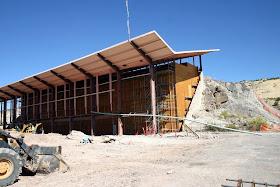Improving the strength and stability of the QVC involves better anchoring of the building’s steel skeleton to the ground. One part of that will involve increasing the size of the concrete footers and adding concrete substructure between the beams. To that end, long boxes of rebar will be set into concrete and serve as attachment points for the steel pillars. However, there are several steps to this seemingly simple action.
First is the rebar itself. What appears at first as a jumbled mass of rods scattered across our parking lot is actually a well organized and thought out erector set.
Each rebar box is made up of many separate rods of different shapes and lengths. And each has ends that are bent to very precise angles that are dictated by that rod’s position in the framework. Reference must be made to some very visually confusing blueprints to determine where each piece of rebar is to be placed.
To form a rigid structure each piece of rebar needs to be tied to others. Welding isn’t necessary because in the end all this will be set in concrete. However, the wiring keeps the pieces in place. Hundreds of ties need to be done for each box.
At first the wiring can be done on saw horses.
But when the longer pieces of rebar are added the whole structure needs to be suspended.
Once a box is completed, work starts on the next. Eventually each will be set in the ground and concrete poured into the trench. We will come to that in a future post.
Photos: National Park Service.
Sunday, September 5, 2010
Thursday, September 2, 2010
THEN AND NOW (INTERMEZZO)
The QVC project is in a transition phase. The major demolition actions (gutting of building, removal of administrative wing, extraction of the crane, and demolition of the Rotunda) are completed. Presently we are strengthening the steel skeleton of the building with pilings, new footers, etc. This will continue for another month or more. The final phase will involve rebuilding and rehabilitating what will become the new building, installing new museum exhibits, and uncovering and cleaning the quarry face and its dinosaur bones.
So this is probably a good point at which to take a look at how far we have come. Remember, some of the former building will not be replaced and is now just space!
Photos: National Park Service
So this is probably a good point at which to take a look at how far we have come. Remember, some of the former building will not be replaced and is now just space!
THE EXHIBIT HALL
 | |||||
| THEN ... |
 |
| ... AND NOW |
THE ROTUNDA AND ENTRANCE RAMP
 |
| THEN ... |
 |
| ... AND NOW |
THE ADMINISTRATIVE WING
 |
| THEN ... |
 |
| ... AND NOW |
EXHIBIT AREA
 |
| THEN ... |
 | |||
| ... AND NOW |
THE PALEONTOLOGY LAB
 | ||||
| THEN ... |
 |
| ... AND NOW |
THE QUARRY FACE
 |
| THEN ... |
 |
| ... AND NOW |
THE GRAND VIEW
 |
| THEN ... |
 |
| ... AND NOW |
Photos: National Park Service










